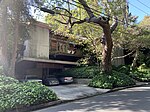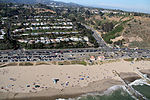Pacific Palisades Business Block
Los Angeles Historic-Cultural MonumentsMid-City, Los AngelesPacific Palisades, Los Angeles

The Business Block building is a historic building located in Pacific Palisades, California, that was designed by architect Clifton Nourse and dedicated in 1924. The building is 30,000 square feet (2,800 m2) and sits on 36,000 square feet (3,300 m2) of land. The Business Block building is located between Antioch, Swarthmore and Sunset in the Village neighborhood of Pacific Palisades, an area in the Westside of Los Angeles, California.
Excerpt from the Wikipedia article Pacific Palisades Business Block (License: CC BY-SA 3.0, Authors, Images).Pacific Palisades Business Block
North Swarthmore Avenue, Los Angeles Pacific Palisades
Geographical coordinates (GPS) Address Nearby Places Show on map
Geographical coordinates (GPS)
| Latitude | Longitude |
|---|---|
| N 34.0472 ° | E -118.5261 ° |
Address
Starbucks
North Swarthmore Avenue
90402 Los Angeles, Pacific Palisades
California, United States
Open on Google Maps







